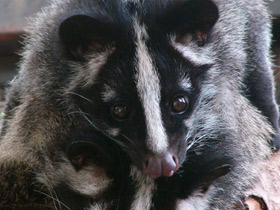The masked palm civet, the gem-faced civet or Himalayan palm civet(Paguma larvata)
The masked palm civet (Paguma larvata), also called the gem-faced civet or Himalayan palm civet, is a viverrid species native to the Indian subcontinent and Southeast Asia. It has been listed as least concern on the IUCN Red List since 2008 as it occurs in many protected areas, is tolerant to some degree of habitat modification, and widely distributed with presumed large populations that are unlikely to be declining.
The genus Paguma was first named and described by John Edward Gray in 1831. All described forms are regarded as a single species.
In 2003, masked palm civets at a wildlife market in China were found to have been infected with the severe acute respiratory syndrome coronavirus.
Appearance and distribution
Paguma larvata is a species of carnivorous mammal in the family Viverridae.
It is the only species of the monotypic genus Paguma.
Paguma larvata is a stealth predator, common in jungles from northern India to southeast Asia and China. It also inhabits some islands: Borneo, Sumatra, Taiwan, Andaman and Nicobar. In the early 20th century, the Himalayan civet was introduced into Japan. It can also be found in other habitats, such as deciduous forests and densely shrubby plains. The Himalayan Civet can also be found in mountainous areas (up to 500 m above sea level).
This medium-sized mammal measures between 51 and 76 cm, has a tail of half a metre and weighs between 3.6 and 6 kg. This raptor has no spots or stripes (unlike its relatives), its colour ranges from orange to grey, its legs are usually dark or black and its snout can be white or black. The civet's anal glands secrete a foul-smelling fluid that repels enemies.
Lifestyle and reproduction
This nocturnal, semi-aquatic animal spends up to 80% of its active time in trees. During the day, Paguma larvata sleeps in the canopy of trees (growing near water sources) in hollows or dense thickets. Paguma larvata feeds on fruits, small animals, birds and insects.
Paguma larvata has a solitary and territorial lifestyle, and only mates during the breeding season. The area of an individual plot can vary from 1 to 6 km2 (males have larger plots than females). Paguma larvata marks its territory with secretions from its anal glands. The female gives birth to 1 to 4 cubs twice a year, which are born in dens high up in trees. The pups' eyes open on day 9 and they reach adult size at three months of age.
Figures 1 and 2 show coffee seeds that have passed through the digestive tract of Paguma larvata.
Ecology and behaviour
The masked palm civet is a nocturnal solitary predator that is occasionally active during the day. It is partly arboreal.
When alarmed, the animal sprays a secretion from its anal gland against the predator. The spray is similar in function to that of a skunk, and its conspicuousness serves to deter other predators.
Feeding and diet
The masked palm civet is an omnivore feeding on rats and birds as well as on fruit such as figs, mangoes, bananas, and leaves. Scat analysis indicates that they also eat mollusks, arthropods, bark and to a lesser extent snakes and frogs. The composition of the diet varies between seasons and sites.
Threats
The major threats for the masked palm civet are continued habitat destruction and hunting for bushmeat. It is widely offered in restaurants in southern China and is also eaten in Vietnam. Masked palm civets are often victims of illegal animal trafficking to meet the demands in China and Vietnam; 100 civets were confiscated in April 2021. Despite relocation to Save Vietnam Wildlife, a wildlife rehabilitator, at least 8 civets died due to stress and injuries.
Conservation
Paguma larvata is protected in Malaysia and China, but not Thailand and Nepal. The population of India is listed on CITES Appendix III.
















































